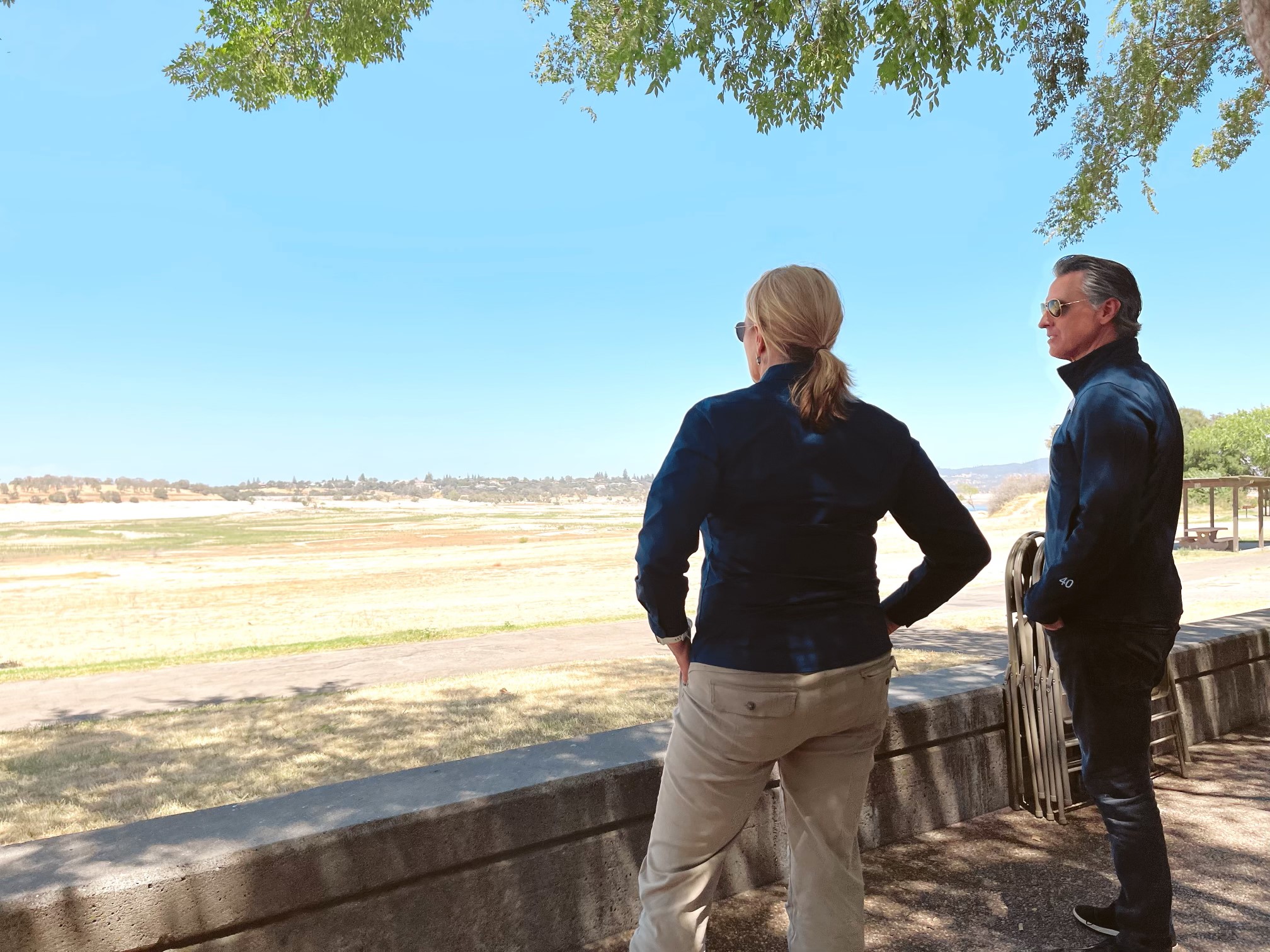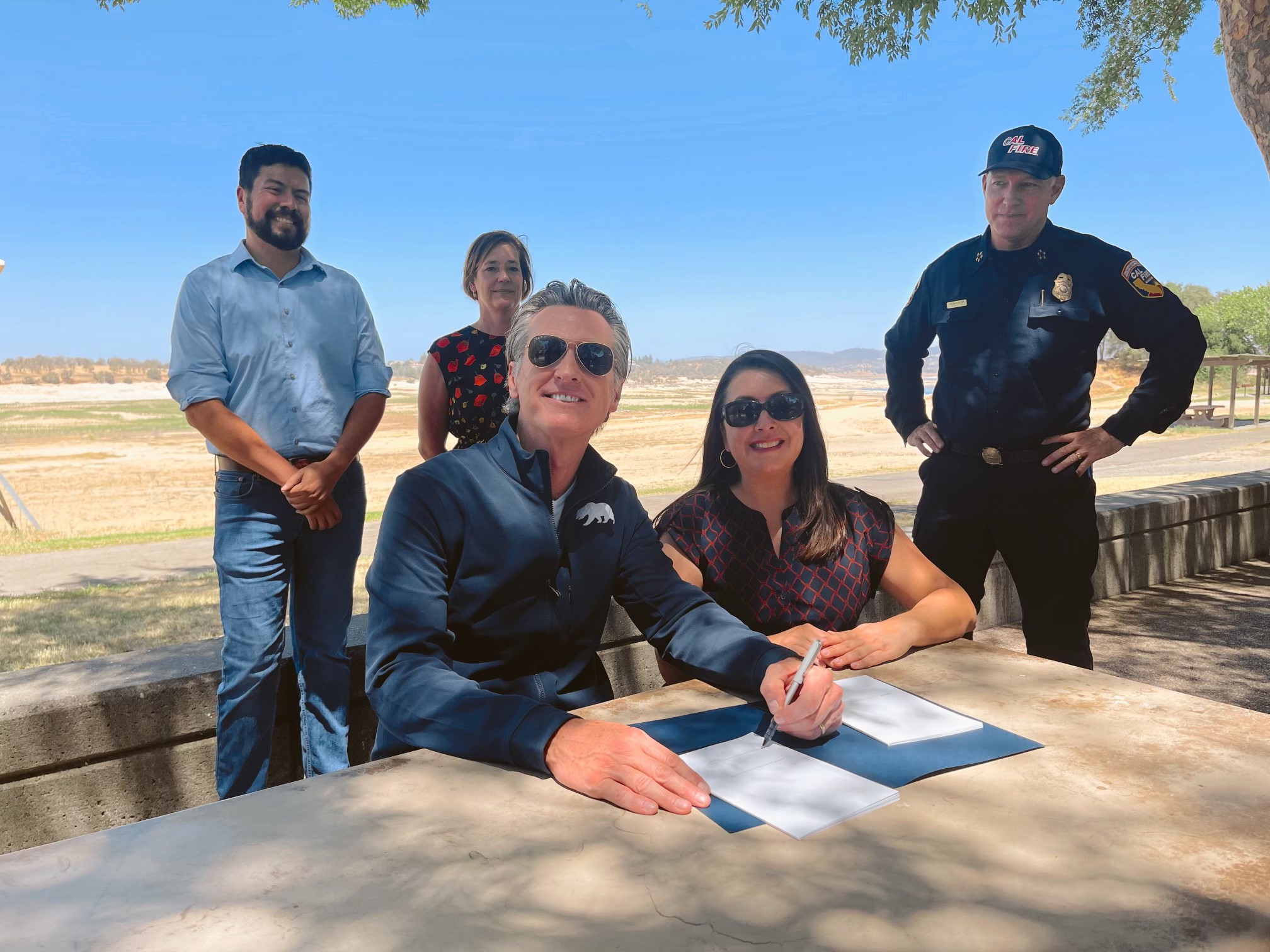Climate change emergency brings unprecedented drought, heat waves, wildfires to western states
Budget trailer bill implements important drought response programs and accelerates deployment of the Governor’s $3.9 billion investment for zero-emissions vehicle programs
Builds on California Comeback Plan’s $5.1 billion for drought relief, preparedness and long-term water resilience and $2.2 billion to build wildfire resilience and emergency preparedness
FOLSOM LAKE – Governor Gavin Newsom today toured Folsom Lake reservoir and visited the North Fork American River Shaded Fuel Break in Placer County with new Federal Emergency Management Agency (FEMA) Administrator Deanne Criswell to show the massive impacts of climate change, including drought, heat waves and wildfires. The Governor also signed budget trailer bill AB 148 to expedite the state’s response to severe drought conditions, outline guidelines for the state’s program to pay down past-due water and wastewater bills, increase oversight of the state’s critical infrastructure, protect the environment from oil spills and increase access to California State Parks and reduce park fees for disadvantaged groups.
“As California and the West contend with the ravages of this global climate emergency – from catastrophic wildfires to severe drought to record high temperatures – our state is leading the nation with bold solutions to protect people and the environment,” said Governor Newsom. “As our federal partners consider climate change impacts across the country, I want to thank FEMA Administrator Criswell for taking the opportunity to see first-hand just how dire this crisis is in the western states and how we’re responding to the new climate reality.”
California is taking nation-leading action to tackle the climate crisis, including the California Comeback Plan’s $3.9 billion package to hit fast-forward on our zero-emissions vehicle goals. The legislation signed today accelerates the state’s ability to deploy these funds, ramping up progress toward our climate and transportation goals.


Governor Newsom signs resources budget trailer bill and meets with FEMA Administrator Criswell
The legislation signed today, AB 148, includes provisions that:
- Provide flexibility to state agencies to expedite funding for areas experiencing drought conditions.
- Provides Administrative Procedure Act exemptions for Zero Emission Vehicle programs included in the state budget, which enable departments to quickly deliver funding and accelerate the state’s progress toward meeting its climate and transportation goals.
- Make technical changes needed to establish the Office of Energy Infrastructure Safety at the California Natural Resources Agency.
- Establish guidelines for the implementation of the California Water and Wastewater Arrearage Payment Program.
- Make statutory changes to address a declining balance and structural deficit in the Oil Spill Prevention and Administration Fund, which include raising a per barrel fee from 6.5 cents to 8.5 cents and an expansion in the definition of oil to include new renewable fuels.
- Establish the “California State Park Adventure Pass” pilot program, which permits any child in the 4th grade, or 4th grade equivalent, and their families who are California residents the ability to visit an eligible state park.
- Waive the $5 fee for the “Golden Bear Pass” for disadvantaged groups as specified in existing law until July 1, 2024.
- Establish the Climate Smart Agriculture Account to accept federal, state, industry, philanthropic and private funds to support climate smart agriculture program funding, such as the Healthy Soils program.
Additional Measures on Drought and Long-Term Water Resilience
Governor Newsom’s California Comeback Plan includes $5.1 billion over four years for immediate drought response and long-term water resilience to ensure that California has the water infrastructure it needs to grapple with more extreme seasons of wet and dry.
- $727.7 million to meet current and anticipated future water supply needs while building regional capacity to endure dry conditions. These investments will fund emergency drought relief projects that help secure and expand water supplies; small supplier and rural community drought contingency planning and preparedness projects; the state cost-share of a federal desalination research hub; address the increased need for species monitoring and project permitting; help address drought impacts on state wildlife areas; and local water resilience capacity building that includes outreach to disadvantaged communities.
- $365.2 million across four years to leverage $1.8 billion in federal funds for the American River Common Features flood control project, the maintenance and strengthening of levees, the support of emergency flood response activities in the Sacramento-San Joaquin Delta, and the support of collaborative flood risk management.
Additional Measures on Wildfire and Emergency Response
Amid unparalleled risk of catastrophic wildfire and ever-present climate change, Governor Newsom has invested $2.2 billion to combat and prepare for wildfires and advance emergency response, the largest investment in our state’s history.
Expanded Staffing and Equipment Investments
- $142 million to support 30 additional fire crews, helping CAL FIRE respond to wildfires throughout the fire season and complete fuel reduction projects.
- $38.9 million to staff both current and three additional CAL FIRE crews in addition to extending the surge of 1,399 seasonal firefighters until winter.
- $48.4 million to phase in 12 new FIRE HAWK helicopters and seven large air tankers.
- $33.7 million to replace two CAL FIRE helicopter bases and establish an Emergency Operations Center for Southern California to help save lives and properties.
- $9.5 million to build a wildfire forecast and threat intelligence center.
- $29.9 million to create an Office of Equity at Cal OES and to permanently fund the Listos California grant program to connect with disaster vulnerable communities.
- $95 million for additional administrative, operational, IT and mission support staff and related capacities.
- $5 million research grant for equipment and strategies to protect firefighters from dangerous conditions during wildfires
Improved Forest Health and Management
- $1.5 billion to reduce the risk of catastrophic wildfires by increasing the pace and scale of forest management projects, through thinning overgrown forests, increasing prescribed burns and replanting trees. This investment will also enable regional efforts to build a pipeline of wildfire resilience projects, expand fire-adapted homes and communities, improve stewardship on state lands and create high-road jobs while jump-starting small businesses that meet California’s climate objectives. (Early action contributed $536 million towards this agreement, supplemented by a proposed $458 million in the current fiscal year, and an additional $500 million shall be advanced where further funding is needed.)
Direct Investments to Communities
- $100 million all-hazards initiative to build disaster-resilient communities by covering local government costs for a federal disaster resilience grant program.
- $150 million to develop and enhance fairground and community resilience centers that will provide shelter and support base camps during emergency events.
- $100 million in local government assistance to assist counties and cities during and after disasters.
###
